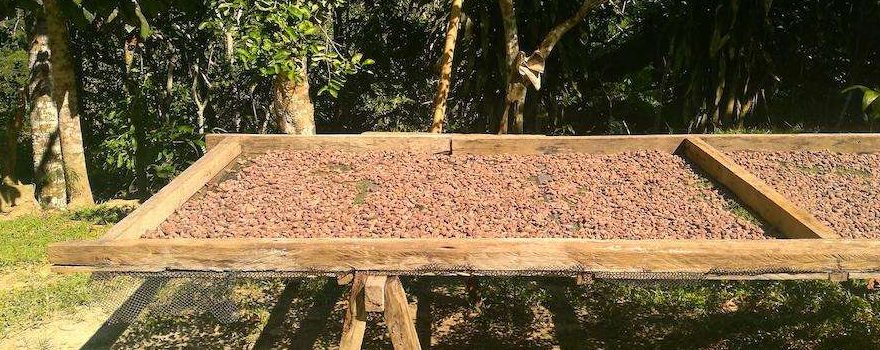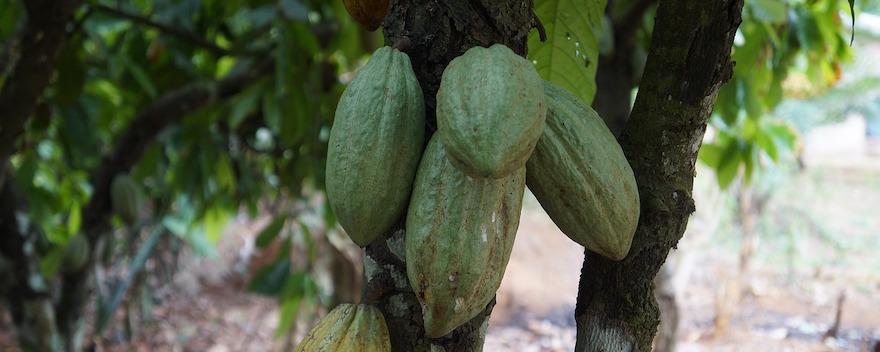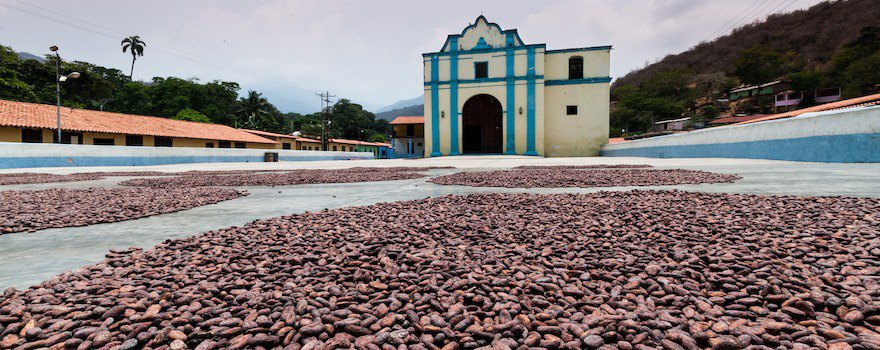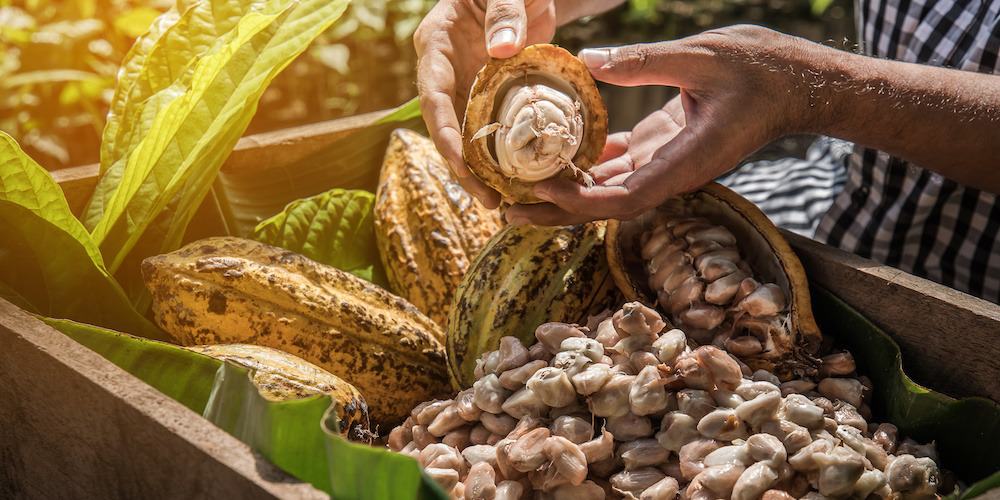What is criollo cacao?
The art of cacao cultivation
From Africa to South America via Asia, many countries cultivate cocoa. Although the global cocoa market has become the monopoly of large international firms, many small producers still make a living today from cocoa cultivation. Rich in ancestral know-how, they cultivate a few hectares of cocoa trees and are self-sufficient, from planting through to drying the beans in the sun.
Also read the The day we harvested cocoa in the Amazon!
Cocoa cultivation is a true art and goes through a multitude of steps : planting the cocoa trees, crop management, harvesting the pods, pod opening, fermentation of the beans then drying in the sun, selling. But it all begins with a crucial first step : selecting the cocoa varieties.

Different cacao varieties
There are today various cocoa varieties, including heirloom and hybrid varieties. Among them, only three are predominantly used by chocolatiers : forastero, trinitario and criollo.
On its own, forastero represents 80 % of world production. If this variety was preferred to others, it is because the tree is very productive, hardy, resistant to disease and yields an early harvest. But the choice of yield was made at the expense of taste. Indeed, beans of the forastero variety are rich in tannins, which give them an acidic and very bitter flavor.
The trinitario variety, for its part, is a hybrid resulting from the crossing of criollo and forastero. Thus, it combines some of the flavor qualities of one with the yield capabilities of the other. A trinitario cacao tree can produce 150 pods per year. But this variety has an acidity that is not necessarily appreciated.
Specific characteristics of criollo cacao
The criollo variety is the most refined and the most noble. It represents only 5% of the world’s production. Criollo pods are usually green, but some subvarieties are red. As they ripen, they become yellow or yellow-orange. They have a strong, delicate and aromatic flavor. Very low in acidity and almost without bitterness, criollo is the most interesting from an aromatic standpoint.

But this high-quality variety is produced in small quantities worldwide. Delicate to cultivate and fragile, its growth is slow and its yield is low. Furthermore, the criollo cacao tree is susceptible to diseases and copes poorly with the warming climate that threatens global cacao production. That’s why varieties that are more productive and resistant are generally preferred, although they are far less interesting to the taste buds.
History and development of criollo cacao
Origin and discovery
At the beginning of the colonization of the Americas, the Spaniards became interested in the cultivation of cacao by local populations, notably in Mexico. The Aztecs then dominated Central America. They used cacao for economic purposes (it served as a currency) and for ritual purposes.
Not very fond of the original Aztec recipe for beverages made from criollo cacao (xocoatl), which were rather bitter and spicy, the Spaniards decided to sweeten it by adding cane sugar and honey. Entire shipments of cacao were brought back to Spain where, transformed into chocolate or a drink, it would enjoy great success.
To meet the growing demand, the Spaniards sought to develop the cultivation of cacao trees in the Americas. In 1525, they chose the island of Trinidad, off the coast of Venezuela, to plant criollo cacao. Criollo actually means ‘creole’ in Old Spanish.

Meanwhile, trade developed and enabled the discovery of a new variety of cacao with purple beans. To distinguish it from the criollo, it came to be called « forastero » or « foreign » in Spanish.
In 1727, a hurricane and an outbreak of the Phytophthora fungus decimated much of the criollo plantations on the island of Trinidad. Forastero was then planted — less fragile, more robust and productive. The two varieties mixed, giving rise to the Trinitario hybrid. Its cultivation gradually surpassed that of criollo cacao.
Criollo cultivation today
Although it represents only a tiny portion of the world’s cacao production, the criollo bean remains the most prized in terms of flavor. Today it is mainly cultivated in Central and South America, in the Caribbean, in Peru, Mexico, Venezuela and Colombia.
In Venezuela, out of the 6,000 tons of cocoa produced each year, only 3% belong to the criollo variety. The small village of Chuao, located west of Caracas, is known for producing the best cocoa in the world: a criollo grown under an ideal microclimate and processed according to artisanal methods unchanged for 400 years. Barely 20 tons of criollo beans are harvested and exported each year. But the success of criollo lies in this rarity and preciousness.

Today, the criollo variety is used in cocoa breeding programs and in the development of new varieties.
Why choose criollo cacao?
When you choose your next chocolate bar, we encourage you to discover the criollo variety, not only for its flavor qualities but also to support important causes.
The intense flavor of criollo chocolate
It’s no wonder the criollo variety is prized and sought after by top chocolatiers. All chocolate lovers agree: it is the only one to offer flavors that are at once complex, intense, and delicate.
The flavor of criollo beans can also differ from one production region to another, allowing for a wide and varied palette of aromas. The taste of cocoa is expressed in terroirs, just like wine. Criollo is also interesting for its secondary fruity notes that linger long on the palate. You can find notes of nuts, caramel, even blueberries !

Support for small local producers
Because it does not offer a sufficiently high yield, the criollo variety is neglected by the major leading chocolate companies (Hershey, Ferrero, Lindt…). Part of its cultivation is therefore carried out by the small local producers. By choosing this variety, you financially support and help preserve an ancestral craft.
Preserving an ancient variety
Gradually, old cacao varieties have been replaced by hybrid varieties. This is how agronomists created CCN-51, resulting from a cross of the iquitos/criollo/amelonado varieties, as well as the ‘Mercedes’ cocoa.
The latter offers record yields and produces after just 18 months, compared with 4 to 5 years for a conventional cacao tree. The global cocoa market therefore seems to be betting on hybrid varieties to meet demand, even if it means producing chocolate with standardized flavors.
On the other hand, the old varieties are struggling to survive. Today, as we’ve seen, criollo represents only 5% of global production. By purchasing criollo cocoa, you therefore have the opportunity to contribute to the preservation of this ancient, local variety.



